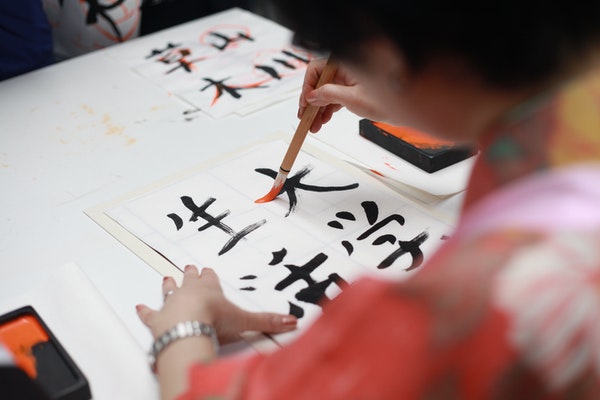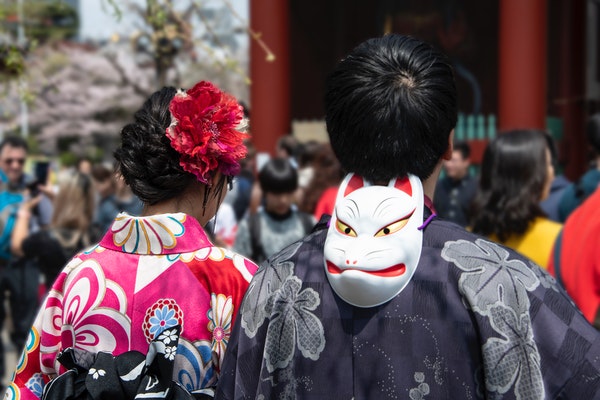You Can Learn Japanese By Yourself
Japanese is an awesome language, and learning it will definitely benefit you. But, it may seem like tackling a huge language like Japanese is an impossible task. Where do you even begin? What method is best to learn Japanese? Can you even learn Japanese by yourself? Absolutely, you just need a reliable guide to get you through the first few steps. So, this is the best way any Japanese beginner can start learning. Discover how to learn Japanese easily by yourself or with the help of others.
How Long Does It Take to Learn Japanese?
“Well, even if I can learn Japanese by myself, it will surely take me longer without a tutor?
Not really.
While there’s no clear number for how long it takes to learn a language, there are definitely ways we can predict how fast you can learn Japanese. The Foreign Service Institute (FSI) estimate is one of these. They predict an average English native speaker would need 2200 hours of study to reach fluency in Japanese. That seems like a lot. But, that estimate is regardless of the language learning method you use.
Imagine that you can learn Japanese at your own pace. Using the best language learning methods. And relying on the most current language learning theories. With all of these tools on your belt, you can definitely tackle Japanese faster than a government agency predict. Just follow this step-by-step guide to truly make your Japanese studies effective.

10 Steps for the Best Way to Learn Japanese
This step-by-step guide is a must-have for every beginner. Whether you want to learn Japanese to visit Japan or you’re using the language for your education, these steps aren’t just useful. They’re crucial to reaching Japanese fluency as fast as possible.
1. Find Your Japanese Learning Resources
Before you dive into the world of language learning, you have to decide how you want to learn Japanese. There are a lot of different methods to go about it. So, choose the one that works best for you. How do you know that it works well for you? Well, firstly you enjoy it. If you have fun, you’re on the right track. Secondly, it makes you progress towards Japanese fluency.
Here are some common language learning options. Some are more effective than others, and some are also more pricey than others. Make sure you choose a reliable option that doesn’t break your budget.
- Join a Japanese Class: The first instinct of every language learning is to jump to a class. This urgency for a language school comes from your high school experience. But, for many, a classroom setting is too stressful. Make sure your classmates don’t limit your studying efforts. And also make sure a college class doesn’t run you into thousands of dollars of student loans.
- Hire a Private Tutor: Private tutors can give you their full attention and help you progress towards Japanese fluency quickly. But, be prepared to pay for their time and expertise fairly.
- Purchase Textbooks: There are some awesome Japanese textbooks out there to learn from. These are reliable and peer-reviewed tools, even if learning from them is a little slow. Plus, they’re a cheaper investment than a lifetime of college debt, that’s for sure.
- Download a Language Learning App: The best way to learn Japanese is ultimately with an app. It’s a convenient, fun, and reliable way to learn the language. But, you need to be careful, as only the best Japanese apps are built with effective learning in mind. Choose an app that makes you speak Japanese, not type it.
2. Learn Japanese Characters
I bet you’re itching to learn actual Japanese at this point. So, the first holy step of learning Japanese always has to be learning the Japanese alphabet and its characters. Well, all three Japanese scripts actually. Japanese uses characters of three different scripts: kanji, hiragana, and katakana.
- Kanji characters originate from Chinese. Here, one character conveys one meaning, so you have to learn them individually. The bad news? There are over 2000 kanji characters in Japanese. The good news? You don’t have to learn them all at the same time.
- Hiragana characters reflect the Japanese language phonetically, and there are only 46 them. You use hiragana to write words of Japanese origin.
- Katakana characters are just like hiragana. There are 46 of them, and they all reflect the same sounds. So, why is there two phonetic alphabets in Japanese? Katakana characters are used to write words of foreign (but not Chinese) origin.

3. Focus on the Most Common Japanese Words
Fluency isn’t about how many words you know. It’s about using the right ones at the right time. So, those who immediately drill hundreds of vocabulary words and call their boring language learning routine a success need to ask themselves: would you use all that knowledge in a conversation with a local?
Of course not, because even locals don’t use their full vocabulary every day. They only use about 20% of the words they know for 80% of their conversations. This is called the Pareto Principle. And it’s your secret weapon to learning Japanese fast. If you can learn the most common expressions, you’ll reach Japanese fluency in record time.
Wondering where you can find this list of useful Japanese words and phrases? As luck would have it, OptiLingo already collected all the vocabulary you need to achieve Japanese success. Just download the app to access this awesome list and save time on your Japanese studies.
4. Review Your Japanese Lessons to Remember Them
As great as your essential vocabulary list is for learning Japanese, going through it once isn’t the best way to learn the language. If you truly want to remember your vocabulary studies, make sure you review often with spaced repetition.
Your brain is actively forgetting. This is true for every new information you try to remember. After learning something, you’ll forget most of it within a day. A week later you’ll have less than 20% of your material memorized. The name of this phenomenon is the “Forgetting Curve”.
The only way to fight against the “Forgetting Curve” is with spaced repetition. This means that whenever you’re about to forget your material, you’ll repeat your lesson and reinforce your memories. In time, you can decrease the frequency of these reviews. And through spaced repetition systems, you’ll have committed all your Japanese study materials to your long term memory.
5. Practice Pronouncing Japanese Often
What use is learning Japanese if you’re too shy to talk to locals when the time comes to speak to them? The only reason anyone’s too shy to talk in a foreign language is that they haven’t practiced speaking enough. To avoid that fate, get ahead of it. Start speaking in Japanese as soon as possible. From the first lesson onward, you need to try and get comfortable with the language.
Most language learners experience anxiety because they’re afraid that their accent or pronunciaiton isn’t good enough. But, the only reason to truly get good at that is with practice. Break the evil cycle and start pronouncing Japanese words right away.

6. Create an Immersive Korean Experience at Home
Traveling to Japan is a luxury for many of us. But, that doesn’t mean you can’t bring a little bit of Japan into your home. All of the following activities help you learn Japanese and spice up your language learning routine. And, you know that the best way to learn Japanese is to have fun.
- Watch Grammar Videos on YouTube: YouTube is a great resource. It’s easily accessible and free. So, just watch some videos about the culture or grammar if you’re ever bored. Just be careful you don’t start watching cat videos for hours afterward. YouTube is a slippery slope like that.
- Watch Japanese Films: Japanese cinema and film industry is amazing. Whether you watch a Studio Ghibli film or one from the Godzilla franchise, every film includes listening to authentic Japanese and learning useful vocabulary.
- Read Japanese Manga: Manga is like a Japanese comic book genre. These stories are great reading exercises, and you can discover more about modern Japanese culture through them.
- Play Japanese Video Games: The gaming industry lives and breathes in Japan. Surely, you’ve heard of Nintendo, Pokemon, and Legend of Zelda. All of these games were developed and created in Japan. So, play them in Japanese for an authentic Japanese gaming experience.
7. Read the News in Japanese
One of the best way to learn how to read in Japanese is to read some Japanese newspapers. Of course, you don’t need a physical newspaper. You can read Japanese blogs, online magazines, and articles as well. Everything helps when you’re learning Japanese.
The obvious reason why this exercise is useful is that you get used to how kanji, hiragana, and katakana interact in one common writing system. But, reading Japanese news also helps you keep up-to-date on the latest events. So, be informed and learn Japanese at the same time with this simple trick.

8. Record Yourself to Have the Best Pronunciation
If you’re worried about how good or bad your Japanese pronunciation is, you can always ask a Japanese person to correct you. But, of course, not everybody has Japanese friends readily available.
If all else fails, use this simple trick to master the right Japanese accent: take your phone, and record yourself speaking in Japanese. Then, listen back to the tape. You’ll hear which parts of your pronunciation sounds accurate, and what areas you need to improve on.
9. Don’t Be Afraid to Make Mistakes
Ultimately, the best way to learn Japanese is to just give it a go. And if you make mistakes, learn from them. Without a doubt, you’ll make mistakes as you’re learning Japanese. But, that’s really how you can learn a language. There’s nothing to be embarrassed about.
Fear of embarrassment can lead to a lot of people quitting language learning. But, if you give up, you really won’t learn Japanese. Rise up and conquer your fears, and you’ll definitely be fluent in Japanese soon.
10. Download the Best App to Learn Japanese
You can follow all of the tips above for the best way to learn Japanese. Or you can download an app that already does all of that for you. OptiLingo gives you the list of the most common Japanese words. It also makes you speak the language as you’re practicing. And it repeats your lessons so you effortlessly enforce spaced repetition.
It’s cheap, convenient, and very fun to use. So, why not give OptiLingo a go? Experience what easy Japanese learning feels like once you have the support of OptiLingo!







